6th Grade Math Standards: 6.NS.6 Understand a rational number as a point on the number line. Extend number line diagrams and
coordinate axes familiar from previous grades to represent points on the line and in the plane with
negative number coordinates.
a. Recognize opposite signs of numbers as indicating locations on opposite sides of 0 on the
number line; recognize that the opposite of the opposite of a number is the number itself,
e.g., –(–3) = 3, and that 0 is its own opposite.
b. Understand signs of numbers in ordered pairs as indicating locations in quadrants of the
coordinate plane; recognize that when two ordered pairs differ only by signs, the locations of
the points are related by reflections across one or both axes.
c. Find and position integers and other rational numbers on a horizontal or vertical number line
diagram; find and position pairs of integers and other rational numbers on a coordinate plane.
6.NS.7. Understand ordering and absolute value of rational numbers.
a. Interpret statements of inequality as statements about the relative positions of two numbers
on a number line diagram. For example, interpret –3 > –7 as a statement that –3 is located to
the right of –7 on a number line oriented from left to right.
b. Write, interpret, and explain statements of order for rational numbers in real-world contexts.
For example, write –3o
C > –7o
C to express the fact that –3o
C is warmer than –7o
C.
c. Understand the absolute value of a rational number as its distance from 0 on the number line;
interpret absolute value as magnitude for a positive or negative quantity in a real-world
situation. For example, for an account balance of –30 dollars, write |–30| = 30 to describe the
size of the debt in dollars.
d. Distinguish comparisons of absolute value from statements about order. For example,
recognize that an account balance less than –30 dollars represents a debt greater than
30 dollars.
6.RP.3 Use ratio and rate reasoning to solve real-world and mathematical problems, e.g., by reasoning about tables of equivalent ratios, tape diagrams, double number line diagrams, or equations. a. Make tables of equivalent ratios relating quantities with whole-number measurements, find missing values in the tables, and plot the pairs of values on the coordinate plane. Use tables to compare ratios. b. Solve unit rate problems, including those involving unit pricing and constant speed. For example, if it took 7 hours to mow 4 lawns, then, at that rate, how many lawns could be mowed in 35 hours? At what rate were lawns being mowed?
c. Find a percent of a quantity as a rate per 100 (e.g., 30% of a quantity means 30/100 times the quantity); solve problems involving finding the whole, given a part and the percent. d. Use ratio reasoning to convert measurement units; manipulate and transform units appropriately when multiplying or dividing quantities.
Objective: Convert between percentages, decimals, and fractions; order percentages, decimals and fractions; find the part given whole; find the whole given part; use percentages to solve real world problems
Agenda:
- QSSQ
- Percentages Quiz
- Work on WQ
- After Quiz Challenge
- Pepper
- An integer is all whole numbers, their opposites, and zero
- Intro to Integers
- Integers homework practice
Assessment: Integers notes were done with independent practice and the teacher circumventing the classroom; the quiz was assessed for a grade
Glass Half-Full: I think this is the right time of the year to teach one of the simpler concepts we have. Students do not have to make as many calculations with integers, absolute value, etc. in sixth grade. And at this time of the year (right before Christmas and New Year's), there are plenty of distractions so this is a good time to take it easier.
Regrets: There are still obvious fundamentals lacking in student's abilities to solve percent problems. Not that I'm not accountable for that, but I did send a note off to all parents and guardians about having their child be responsible for calculating the tip at a restaurant because these kids are at the point where they go to restaurants without supervision. Is the tip supposed to be random? Are they just going to Google it? Calculating a tip was something I learned very young, and it's a little disappointing to see the lack of experience my students have with this skill.







